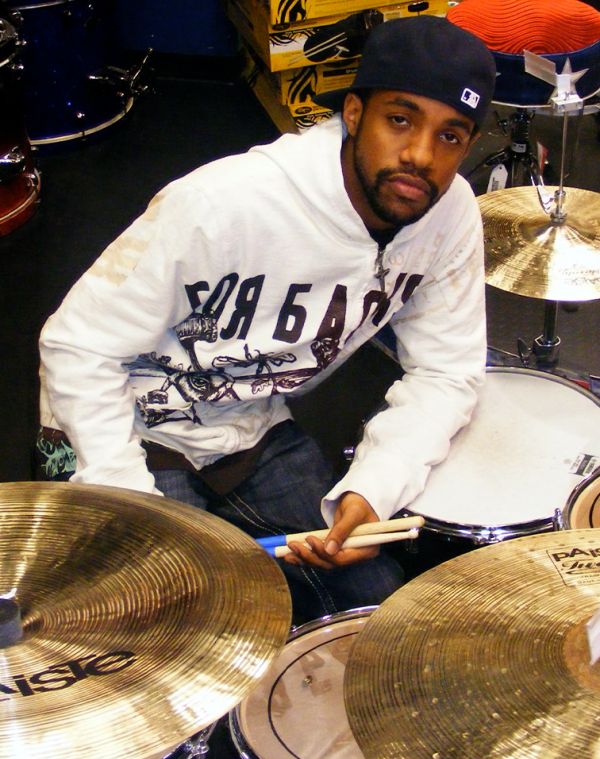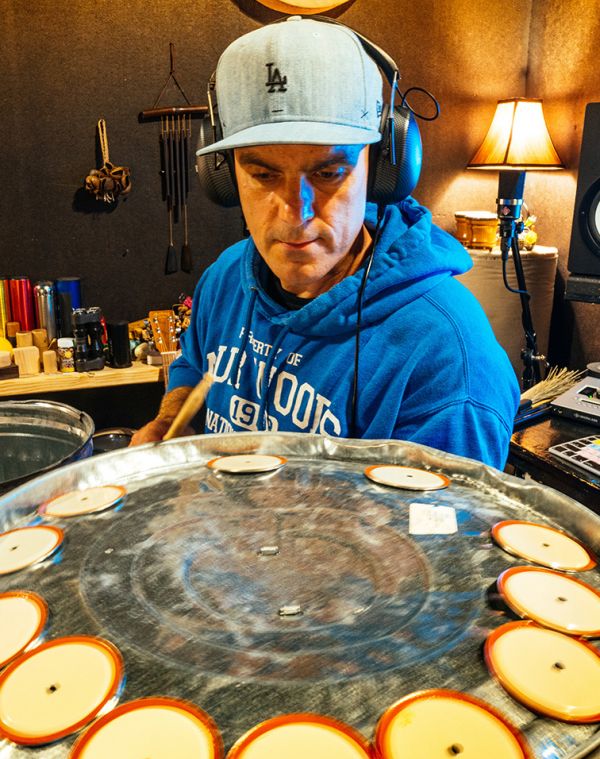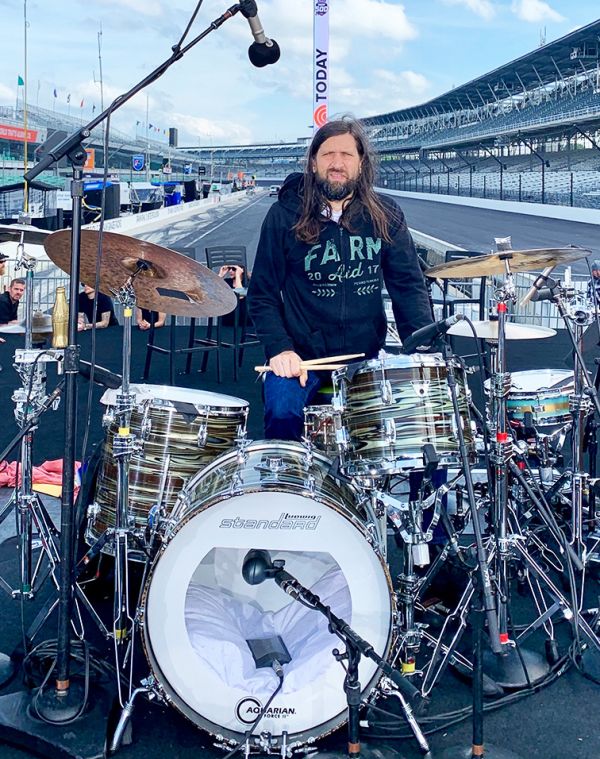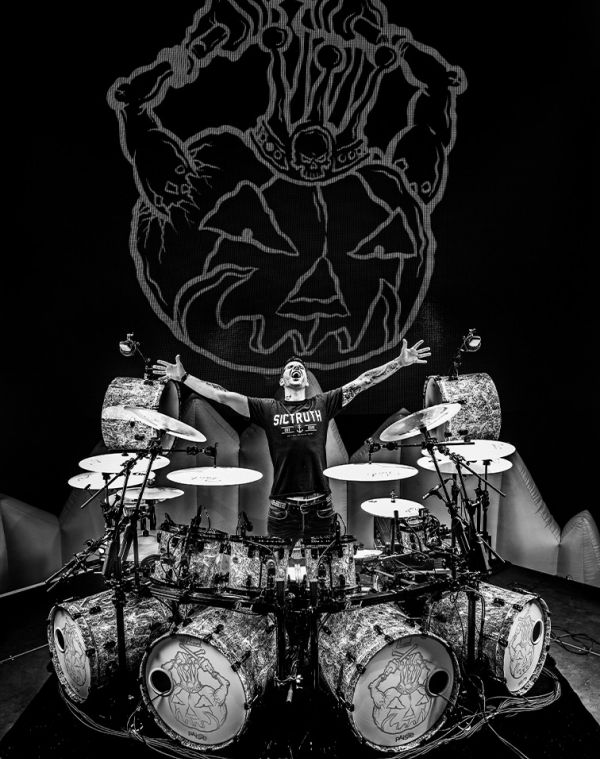

This section is a basic description of cymbals and cymbal types, and how they work and can be used. While foremost an introduction, more advanced players may still find useful information here.
Basic Anatomy

-
Bell
The bell is at the center of the cymbal. Its shape and size affects the sound of the whole cymbal, and it is a useful playing area as it produces a separate type of sound, usually a clear tone, with a dominant higher pitch and sparse overtones. The bell can be used to play rhythmic figures or to accent such figures. It is normally played with the shank of the stick.
-
Surface
The surface of the cymbal produces the majority of the cymbal’s vibration, and therefore its sound. The surface produces a variety of sounds by playing it with the tip of the drumstick, with the shank of the drumstick, with brushes, or with mallets. Playing the surface in different areas can also vary the sound. Playing closer to the edge produces lower and fuller sound, while playing close to the bell produces higher and tighter sound.
-
Edge
Striking the edge of the cymbal produces the cymbal’s fullest sound, commonly referred to as «crash». The edge is the most delicate part of the cymbal and great care should be taken not to damage it in any way through nicks or dings.
-
Taper
The taper is the gradual decrease in thickness from the bell to the edge. Some cymbals are thinner toward edge, but many are not.
-
Curvature or Bow
When cymbals are hammered, the alloy expands sideways at the point of the hammer mark. This expansion causes the cymbal to become curved downward from the bell. The shape can vary from rather flat to very curved.
Cymbal Types
-
Ride
Ride cymbals are larger and usually thicker cymbals. They are mainly used for playing rhythmic figures on the surface and the bell, but they can also be crashed. Ride playing is one of the most detailed and colorful parts of the overall rhythm created together with the bass drum and the snare. Ride cymbals usually build up less so one can play rhythmic patterns that will maintain good definition.
-
Crash
Crashes are often thinner and smaller cymbals. They are mainly used for creating accents by hitting them across the edge. Crash cymbals provide an important element of the overall sound color of the cymbal set. Crash cymbals are usually very responsive so that the full cymbal sound can occur quickly at the desired point in the musical phrasing.
-
Multifunctional
These are cymbals that combine ride and crash character. Ride figures are still audible and useful but the overall sound of the cymbal is lively, and crash accents will be full and usually quite energetic. Cymbals referred to just by weight, such as "Medium" belong to this category as do "Giant Beat" and "Big Beat" models.
-
Hi-Hat
Hi-Hats are two paired cymbals. They are mounted opposite each other on a hi-hat stand. They can be closed or clashed together with a foot pedal. The top cymbal is usually thinner to make the hi-hat more responsive to stick work, and the two cymbals are often quite different in weight and sound. Hi-Hats can be played in a variety of ways: with the stick on the closed surface for distinct rhythmic patterns, half open on the surface or across the edge for full sounding rhythmic patterns. Closing the hi-hat rapidly produces the very short chick sound, which is used for rhythmic patterns, usually in context with ride, snare, and bass drum.
-
Splash
Splash cymbals are very thin, small, and delicate cymbals that respond and fade quickly. Their main use is to set quick accents within the musical context.
-
China or Swish
Chinese style cymbals, so named for their origin, feature an edge area that has a curvature opposite to the curvature of the main surface. The edge is curved upward, so that often the cymbal is mounted upside down for easier playing. Paiste also features «Novo» chinas, with a downward turned edge, so that the bell of the cymbal can also be used. Chinas can be used for crashing or in larger sizes for riding. They are very versatile cymbals with a generally coarse, complex frequency mix, which is often thought of as exotic, oriental and trashy. For simplcity's sake, «Swish» is just another name for this type of cymbal.
-
Sizzle Cymbals
Sizzle cymbals are cymbals of any type with inserted rivets along the edge.
Rivets add a pleasant silvery ring to the sustain of the cymbal. There is no set rule on whether it is better to use a heavy or light cymbal because both work well. With a heavier ride, for example, the rivets will give you the sizzle effect along with the definition you enjoy from that ride. With a lighter ride cymbal, the rivets will only enhance the light sound, giving the cymbal a bit of a drier quality. There are some things you should consider with rivets. The more sizzles you add to a cymbal, the drier the cymbal sound itself will become. Too many rivets can also have a negative effect on the cymbal’s even decay, hence it can stop itself, which appears „unnatural“. You should not drill holes too close to the edge of a cymbal or directly on the change of curvature in a china cymbal. Larger rivets or more rivets will produce more sizzle. Rivets made from brass produce a softer sizzle. Steel rivets produce a brighter, sharper sizzle. Consider having an expert install rivets or contact us for help. -
Stacks
The term stack describes a combination of two or more cymbals, that are stacked on a cymbal stand in order to achieve choked, sizzling and noisy sounds.
-
Hand Cymbals
Hand cymbals are cymbals played in matched pairs by holding one cymbal in each hand and striking the two together. Being called clash cymbals, too, hand cymbals are mainly used in orchestras, marching bands and brass bands. Hand cymbals have leather straps passed through the holes in their bells to allow the percussionist to hold them. Marching bands in addition use leather pads between the outsides of the bells and the percussionist's hands.
Characteristics
-
Size
The larger a cymbal gets, the more volume it produces. Also, the larger a cymbal of the same thickness gets, the lower its pitch will be. Larger cymbals generally sustain longer.

-
Thickness
The thinner a cymbal gets, the more responsive it will be. Also, the thicker a cymbal of the same size gets, the higher its pitch will be. Thicker cymbals generally sustain longer.

-
Weight
Weight is the combination of size and thickness, and thus a relative and complex relationship. Check the classification system for more detail.

-
Bell Size
Bell size has to be considered relative to the overall cymbal size. Generally, cymbals with smaller bells will have a drier sound, and cymbals with larger bells are livelier.
-
Curvature or Bow
The profile or side view of the cymbal is the result of its curvature. A higher/rounder profile will result in a higher overall pitch.

Drumstick Basics
-
Tip
A larger tip has more body and contact with the cymbal and will therefore produce a fuller sound. The type of the tip influences the sound color and character. In comparison, a wood tip produces a warmer, fuller, mellower, and darker sound, while a nylon tip produces a cooler, brighter, more focused sound.
-
Size
The length and thickness of the drumstick influence the sound character and volume of the cymbal. A heavier stick (longer, thicker or both) will produce more volume and fuller sound. A lighter stick (shorter, thinner or both) will produce less volume and lighter sound.
-
Stick Recommendations
The choice of drumstick is extremely personal. It should feel good in your hands and it should produce the type of sound you prefer. It is also a good idea to play more than one type of stick to achieve maximum variety with your cymbal sound. The weight of the stick should correspond to the sizes of your cymbals, so you should not play heavy sticks on smaller or thinner cymbals. There are alternatives to wood drumsticks, but we do not recommend them, because only wood has natural flexibility. Most alternative materials are too rigid and will cause you to weaken or break cymbals. Don’t use metal sticks on cymbals, as they are only meant for practicing purposes on a rubber pad.










